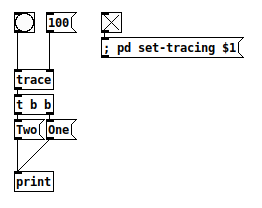@ddw_music said:
In Pd, wires are procedure calls, not gotos.
Are they actually procedures or just conceptually? I would assume the latter but if they actually are procedures can you point me where to look in the source? I get the depth first stuff, I just turned myself around in those edits, hence the follow up post and the disclaimer added to the original post. I did a bit of digging in the source and I think my original point was correct, pd does not do anything weird with how it uses the stack, it is just that without a return stack we can't actually return which means we have to go about/think about things in a different way.
lisp would write
(print (* (random 20) 2))where the last operation to be performed ("print") is at the head of the tree
But there is no tree in lisp, right? it is just a list data structure for the REPL to evaluate. I can't quite grasp how lisp works under the hood, I poisoned my brain with one of those build your own lisp tutorials which I later learned did not actually function in anyway like lisp proper, it was just an easy way to do a lisp like language and I have been lost ever since. Lisp is one of the languages I really want to learn and understand because it is supposedly great for building languages but there is something about it which I fail to grasp.
Regarding Forth since you keep bringing it up, it is no where near as mind bending as people think, in practice you don't spend much time doing that low level RPN stuff; you define some words and use those words to define other words and before you know it you have a purpose built high level DSL for your task. But you have to learn all that low level RPN pushing and popping stuff first. I am a big fan of Forth and what got me interested in language design/implementation was the whim of implementing a language in pd, so I found a language which would seem suitable for that whim and it was Forth, I learned Forth by implementing it in pd.






 They're structured, provide a convenient way for exiting deeply nested loops, and feel similar to Java's exception framework.
They're structured, provide a convenient way for exiting deeply nested loops, and feel similar to Java's exception framework. well, there's a time and place for everything. There are gotos in SuperCollider's C++ codebase, iirc mainly in the long
well, there's a time and place for everything. There are gotos in SuperCollider's C++ codebase, iirc mainly in the long